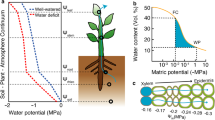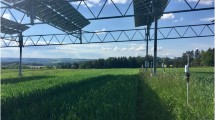Summary
Measurements of CO2 and water vapor exchange were performed on Prunus armeniaca L. with humidity- and temperature-controlled chambers under the climatic conditions of a desert habitat. In apricot, the stomatal response to changes in temperature and water-vapor concentration difference between leaf and air (WD) significantly determined the rates of gas exchange during the day (parts I and II). The effect of climate-controlled stomatal response on the transpiration/net photosynthesis (T/P)-ratio was analyzed and simulated using experiments conducted at constant temperature and/or humidity conditions for input parameters. The measured values of the T/P-ratio at naturally varying conditions of humidity and temperature were compared with calculated results of a model in which it was assumed, (1) that stomata and photosynthetic activity are not affected by air humidity and temperature, (2) that the stomata only respond with a constant photosynthetic activity to changes in WD, and (3) that the stomata respond to both, leaf temperature and air humidity with a constant photosynthetic activity. These simulations facilitated an analysis of the naturally observed changes in the T/P-ratio.
The calculated T/P-ratios were very small if the simulation assumed that stomata only respond to WD at a constant photosynthetic activity. These low predicted values of the T/P-ratio were not obtained under natural conditions, since an increase in WD during the day was correlated with a temperature rise which tended to open stomata and change the photosynthetic activity. Humidity induced stomatal closure did appear to substantially reduce T/P-ratios.
The measured T/P-ratio changed considerably during the year. The lowest T/P-ratios were obtained in the middle of the dry season at a time when stomata responded strongly to air humidity and when optimum of photosynthesis was reached at high temperatures. The daily average T/P-ratio calculated from the daily sum of P and T showed little change during the seasons. A high T/P-ratio was also observed at reduced rates of gas exchange. The T/P-ratios of apricot were compared with different species in different environments.
Similar content being viewed by others
References
Bierhuizen, J. F., Slatyer, R. O.: Effect of atmospheric concentration of water vapour and CO2 in determining transpiration photosynthesis relationships of cotton leaves. Agr. Meteorol. 2, 259–270 (1965)
Black, C. C.: Ecological implications of dividing plants into groups with distinct photosynthetic production capacities. Adv. Ecol. Res. 7, 87–114 (1971)
Cowan, I. R., Troughton, J. H.: The relative role of stomata in transpiration and assimilation Planta (Berl.) 97, 325–336 (1971)
Dunn, E. L.: Seasonal patterns of carbon dioxide metabolism in evergreen sclerophylls in California and Chile. Ph.D. Thesis, University of California, Los Angeles (1970)
Evenari, M., Shanan, L., Tadmor, N. H.: The Negev. The challenge of a desert. Cambridge, Mass.: Harvard University Press 1971
Hall, A. E., Kaufmann, M. R.: The regulation of water transport in the soil-plant-atmosphere continuum. In: Ecological studies, vol. 12, Perspectives of biophysical ecology, D. M. Gates, R. B. Schmerl, eds. Berlin-Heidelberg-New York: Springer 1975a (in press)
Hall, A. E., Kaufmann, M. R.: Stomatal response to environment with Sesamum indicum L. Plant Physiol. (1975b, in press)
Hellmuth, E. O.: Ecophysiological studies on plants in arid and semiarid regions in western Australia. III. Comparative studies on photosynthesis, respiration and water relation of ten arid zone and two semi-arid zone plants under winter and late summer climatic conditions. J. Ecol. 59, 225–259 (1971)
Jackson, W. A., Volk, R. J.: Photorespiration. A. Rev. Pl. Physiol. 21, 385–432 (1970)
Jarvis, P. J.: The estimation of resistances to carbon dioxide transfer. In: Z. Šestàk, J. Čatský, P. G. Jarvis, eds., Plant photosynthetic production. Manual of methods, p. 566–631. The Hague: Junk 1971
Jones, R. J., Mansfield, T. A.: Effects of abscisic acid and its esters on stomatal aperture and the transpiration ratio. Physiol. Plant. 26, 321–327 (1972)
Lange, O. L., Koch, W., Schulze, E.-D.: CO2-Gaswechsel und Wasserhaushalt von Pflanzen in der Negev-Wüste am Ende der Trockenzeit. Ber. dtsch. bot. Ges. 82, 39–61 (1969)
Lange, O. L., Schulze, E.-D., Evenari, M., Kappen, L., Buschbom, U.: The temperature-related photosynthetic capacity of plants under desert conditions. I. Seasonal changes of the photosynthetic response to temperature. Oecologia (Berl.) 17, 97–110 (1974)
Larcher, W.: Orientierende Untersuchungen über das Verhältnis von CO2-Aufnahme zu Transpiration bei fortschreitender Bodenaustrocknung. Planta (Berl.) 60, 339–343 (1963)
Ludlow, M. M., Wilson, G. L.: Photosynthesis of tropical pasture plants. IV. Basis and consequences of differences between grasses and legumes. Aust. J. biol. Sci. 35, 1133–1145 (1972)
Pearcy, R. W., Harrison, A. T., Mooney, H. A., Björkman, O.: Seasonal changes in net photosynthesis of Atriplex hymenelytra shrubs growing in Death Valley, California. Oecologia (Berl.) 17, 111–121 (1974)
Schulze, E.-D., Lange, O. L., Evenari, M., Kappen, L., Buschbom, U.: The role of air humidity and leaf temperature in controlling stomatal resistance of Prunus armeniaca L. under desert conditions. I. A simulation of the daily course of stomatal resistance. Oecologia (Berl.) 17, 159–170 (1974)
Schulze, E.-D., Lange, O. L., Kappen, L., Evenari, M., Buschbom, U.: The role of air humidity and leaf temperature in controlling stomatal resistance of Prunus armeniaca L. under desert conditions. II. The significance of leaf water status and internal carbon dioxide concentration. Oecologia (Berl.) 18, 219–233 (1975)
Stocker, O.: Der Wasser- und Photosynthese-Haushalt von Wüstenpflanzen der mauretanischen Sahara. III. Kleinsträucher, Stauden und Gräser. Flora 161, 46–110 (1972)
Author information
Authors and Affiliations
Rights and permissions
About this article
Cite this article
Schulze, E.D., Lange, O.L., Evenari, M. et al. The role of air humidity and temperature in controlling stomatal resistance of Prunus armeniaca L. under desert conditions. Oecologia 19, 303–314 (1975). https://doi.org/10.1007/BF00348106
Received:
Issue Date:
DOI: https://doi.org/10.1007/BF00348106




